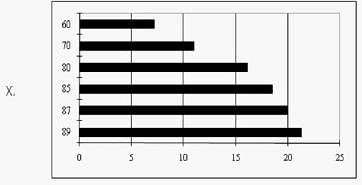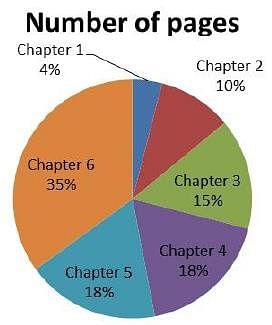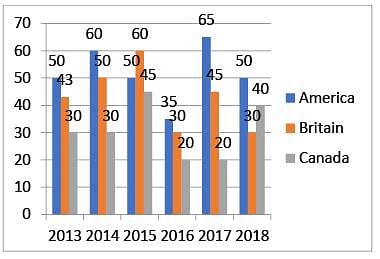APSC CCE Prelims (Paper 2) Mock Test - 6 - APSC CCE (Assam) MCQ
30 Questions MCQ Test APSC CCE Mock Test Series 2024 - APSC CCE Prelims (Paper 2) Mock Test - 6
Select a suitable figure from the Answer Figures that would replace the question mark (?).
Problem Figures: Answer Figures:

(A) (B) (C) (D)

A, B and C together earn Rs.300 per day, while A and C together earn Rs.188 and B and C together earn Rs.152. The daily earning of C is?
| 1 Crore+ students have signed up on EduRev. Have you? Download the App |
The wages of Santhosh and Revathi are in the ratio ratio 6:5. If the wages of each is increased by Rs.6000, the new ratio becomes 38:35. What is Revathi' s present salary?
Refer to the following graph related to the percentage of persons over 25 years of age and with more than 4 years college education living in country X.

What was the average percentage increase per year from 1970 to 1980?
A, B and C can do a piece of work in 11 days, 20 days and 55 days respectively, working alone. How soon can the work be done if A is assisted by B on odd days and C on even days?
Directions
A book is divided into 6 chapters. The following pie chart denotes the percentage of the total pages devoted to each chapter.

The central angle for Chapter 6 is x degrees more than that of chapter 5. The value of x is
The ratio of the number of UG students and PG students in a college is 5:4. If 40% of the UG students and 50 % of the PG students are scholarship holders. What percentage of the students does not get the scholarship?
A shopkeeper sells an article at 12.5% loss. If he sells it for Rs. 92.50 more, then he gains 6%. What is the cost price of the article ?
By selling a pen at a profit of 60% a man got Rs 38 more than one third of its cost price. What is the cost price of pen?
Ratio between two numbers is 3:2 and their difference is 25, then find the smaller number ?
4 men and 6 women complete a piece of work in 8 days while 3 men and 7 women complete it in 10 days. In how many days 10 women can finish the work?
Read the following passage and answer the item that follow. Your answer to this item should be based on the passage only.
The history of UN interventions on migration began with the initiation of the International Labour Organization (ILO) in 1919. Even though there have been several conventions and treaties to protect the rights of migrants and refugees over the years, major intervention by international agencies in managing migration occurred during the neo-liberal era, where short-term mobility of labour is important for global capital to thrive. To match the demand for low- and semi-skilled workers, agencies like the World Trade Organization (WTO) and the World Bank promoted business-friendly migration management approaches, while snubbing worker and migrant rights.
Q. Which of the following is the most logical and critical inference that can be drawn from the passage?
A got twice as many marks in English as in Science. His total marks in English, Science and Mathematics is 180. If the ratio of his marks in English and Mathematics is 2 : 3, what is his marks in Science?
The Christmas season, of course, is an appropriate time of year to reflect on busyness. The time between Christmas and New Year should be a time for reflection and relaxation, but is often stressed. Rather than taking time out after the busyness of Christmas preparations, many of us find ourselves in a whirlwind of sales shopping, sporting activities, or visiting friends or family. One form of busyness is replaced by another. Being busy has become so ubiquitous it has come to mean everything and nothing. As more people identify with the problem of busyness, some of us seek advice from time management experts about how to manage our busy lives. But data suggests that we are not as busy as we think we are. Social scientists who, specialise in researching every day time- use can compare trends in how we spend time from the 1960s onwards. The UK expert on time use, Jonathan Gershuny, claims that actual time spent in work has not increased since the 1960s - but what we mean by busyness has changed over time. In his view, busyness has become a badge of honour. There are a number of reasons for this change in definition. More women in the workforce mean that more households have to juggle both partners working with the demands of domestic routines. Meanwhile, social prestige is associated with being busy and, as we often experience at Christmas, leisure time has become more of an intensive experience.
What is/are the reason(s) for the change in the definition of busyness?
1. Social prestige is associated with being busy.
2. More women in the workforce
Two numbers are in the ratio 7:9. If 12 is subtracted from each of them, the ratio becomes 3:5. The product of the numbers is:
A, B and C jointly thought of engaging themselves in a business venture. It was agreed that A would invest Rs. 6500 for 6 months, B, Rs. 8400 for 5 months and C, Rs. 10,000 for 3 months. A wants to be the working member for which, he was to receive 5% of the profits. The profit earned was Rs. 7400. Calculate the share of B in the profit.
A man buys an article for 20% less than its value and sells it for 20 % more than its value. What is his gain in percentage?
A truck covers a distance of 550 meters in 1 minute whereas a bus covers a distance of 33 kms in 45 minutes. The ratio of their speeds is:
9 kids can finish a bit of work in 360 days. 18 men can finish the same work of piece in 72 days and 12 ladies can finish it in 162 days. In how long can 4 men, 12 ladies and 10 kids together finish the bit of work?
One half of a two digit number exceeds its one third by 6. What is the sum of the digits of the number?
Ramya invested an amount of Rs.60000 to start a business . After 8 months, Bharathi joined her with an amount of Rs .30000. They earned profit Rs. 24500 after one year. What is Bharathi profit ?
A train passes two persons walking in opposite directions to the train at a speed of 5 m/s and 10 m/s and crosses them in 6 seconds and 5 seconds respectively. Find the length of the train?
Two trains of lengths 150 m and 180 m respectively are running in opposite directions on parallel tracks. If their speed is 50 km/hour and 58 km/hour respectively. In how much time will they cross each other?
Study the following graph carefully to answer the questions given below it.
Production of Wheat (in Lakh tonnes) by three different countries America, Britain & Canada over the years

What is the difference (in Lakh tonnes) between the average production per year of the company with highest average production and that of the company with the lowest average production?
Directions for the following (one) item:
Read the following passage and answer the item that follow. Your answer to this item should be based on the passage only.
The impact of environmental disasters is immense but unequal. Houses in poorer areas will often be less stable, storm barriers may be weaker, sanitation is often a problem, emergency services will be poorly resourced - and preventing disease outbreaks may be hindered by the poor state of public health services.
Q. Which among the following is the most logical and essential message conveyed by the above passage?
Based on the following bar graph. (Number of Industrial Townships in 1978 is 160000)

Which was the first year when people were employed in private enterprises?
A alone can do a piece of work in 6 days and B alone in 8 days. A and B undertook to do it for Rs.3200. With the help of C, they completed the work in 3 days. How much is to be paid to C?
Refer to the following graph related to the percentage of persons over 25 years of age and with more than 4 years college education living in country X.

Q. If some other country had three times as many people of 25 and over in 1989 as the country X with the same number of persons completing 4 years of college or more, what percentage of that country’s people of 25 and over would complete college?
Present ages of Sameer and Anand are in the ratio of 5:4 respectively. Three years hence, the ratio to their ages will become 11:9 respectively. What is Anand's present age in years ?
Based on the following bar graph. (Number of Industrial Townships in 1978 is 160000)

If it is known that the total work force in India increases at a simple rate of 10% per annum, then by what per cent does the number of people employed in the Urban Collectives change?





















